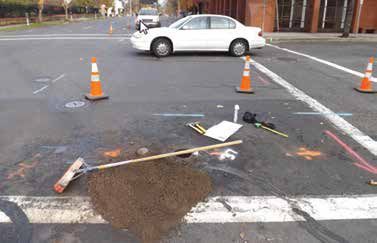
Documenting Accurate Utility Locations
The American Society of Civil Engineers (ASCE) believes that a standard for producing common utility “as-built” data is essential for accommodating and safeguarding public and commercial infrastructure, protecting the public, enabling emerging 3D digital design and construction technologies, and making optimal use of public right-of-way. Currently, utility records are inconsistent throughout the U.S. in spatial accuracy, feature content and format, and thus are negatively affecting damage prevention efforts as well as inhibiting preemptive, coordinated, and sensible design and construction strategies. In 2013, ASCE formed a new technical committee which aimed to revolutionize documentation of newly installed and exposed infrastructure with the non-mandatory consensus Standard Guideline for Recording and Exchanging Utility Infrastructure Data. The standard is sponsored by the Utility Engineering and Surveying Institute (UESI) of ASCE.
The standard committee consists of 37 members forming a multi-discipline team which includes professionals from the oil and gas, telecommunication, power and public works utility industries, as well as representation from subsurface utility engineering, civil design, contractors, transportation research, federal and state agencies, land surveying, Computer Aided Drafting and Design (CADD), Geographical Information System (GIS), Civil Integrated Management (CIM), Building Information Modeling (BIM), machine guidance, and trenchless technology industries.
The standard complements the latest version of the ASCE Standard 38, “Standard Guidelines for the Collection and Depiction of Existing Subsurface Utility Data”. ASCE 38 was designed to standardize the mapping of existing utility infrastructure, whereas this new “utility as-built” standard is to address systematic documentation of newly-installed and exposed infrastructure. The two standards overlap and are harmonized for the documentation of exposed existing infrastructure.
The benefits for having a utility as-built standard are significant toward reducing damages to utilities. Many civil engineers and contractors can attest to the fact that utilities have been the bane to numerous infrastructure projects as a direct result of inconsistent underground utility records. The ramifications of error and risk are great, causing project costs to increase dramatically over the years. Moreover, there is a mandate for standardized digital utility infrastructure data to unleash the many powerful aspects of emerging 3-D applications for facilitating design, clash detection and conflict analytic, BIM, CIM, augmented reality, and machine guidance, etc. Testing of the new “utility as-built” standard indicates it effectively enables the 3-D digital re-creation of the actual physical installation and will enable support of common exchange formats such as LandXML.

FIGURE 1
ASCE 38 is very effective in helping designers and contractors by providing standard guidelines for the collection and depiction of existing buried installations on plans. Now, application of this new, easily-implementable and scalable standard (see Figures 1 and 2) will ensure that accurate and consistent information about the location and nature of new underground utility infrastructure is captured at the time of installation and available for ongoing construction as well as future project development and damage prevention measures.

FIGURE 2
A white paper on the proposed standard is available at: https://www.asce.org/utility-engineering-and-surveying/news/20180112-seeking-comments-onproposed-standard-guideline-for-recording-and-exchanging-utility-infrastructure-data. The technical committee is currently seeking comments on its proposed standard.
Philip J. Meis is a utility engineer and registered as a P E in 15 states. He is active with the following organizations: Chair – ASCE Utility Engineering and Surveying Institute (UESI) Standard Guideline for Recording and Exchanging Utility Infrastructure Data; Vice-Chair – ASCE UESI Utility Risk Management Division (URMD); Member (and former Chair) – ASCE UESI URMD Utility Investigations and SUE Subcommittee; Member – ASCE/UESI 38-18 Standard for the Collection and Depiction of Existing Subsurface Utilities; and an Associate Member of the TRB AFB70 Utilities Committee. He can be reached at pjmeis@umsi.us.
Comments